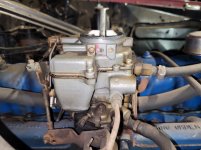Thanks Frank, good tip on the magnet. I noticed today after making the spacer plate to wider the flange for the big bore 1940 carb that most of the restriction is in the aluminum spacer that coolant flows through. Biggest restriction is on the passenger side away from water, I could open it up easily there but there is also an appreciable restriction on the driver side toward where water and I doubt I could open that up all the way. No idea how thin it might be. I left it as it is as we have bigger fish to fry, and that's an easy thing to open up or gasket match the spacer any time.
alwill923, I get the sentiment but until we decide if we're doing a six or small block build for this Falcon I don't want to spend too much time on it, just get it running reliably. It was a one family car before us, spent a number of years in CA used only to take trash cans down to the street apparently. Eventually "restored" 15 years ago and used as a weekend cruiser, shows, etc. It's also not the wife's daily driver yet, her Bronco II is getting a new 4.0 OHV engine, waiting for it to get back from machine work on the block.
I also confirmed the Falcon has a 170, three freeze plugs instead of five for a 200. If we did a six build we would get a 200 or 250 since time and money would be similar. My time is divided among too many projects, I'd rather pick a direction first. Hardened seats are costly and can fail/drop. My machinist advised me that he would do it but probably not worth the cost and risk when doing the FE build. I've run so many heads with questionable stuff lapped in or ground seats by hand over the years never had hardened seats and put hundreds of thousands of miles on them with unleaded fuel. On a small block, if we go that route, I'd never bother with factory iron heads or porting anymore given the lower cost and readily available aluminum heads. Probably same for a 460 next time I build one. Maybe not so easy or simple a decision with a small six though. I see the aluminum head is on backorder.
In any event I got the 1940 carb back together, made a adapter/spacer plate out of 16ga steel, and bolted the carb back on. It runs much better without the massive vacuum leak. Should have the normal mechanical/vacuum advance distributor installed this weekend. Clutch and shift linkage adjustment and figure out the slop in the accelerator linkage and I think it'll pretty good for now.
We spent some time this evening wire wheeling some surface rust in the trunk of this car and Ospho in the trunk, wheel well to quarter seams, etc. It's a solid car underneath but needs treatment of surface rust and such. Biggest issue with this one is the convertible drain gutter is rotted and needs replaced or patched. Nobody seems to make this for '64-'65 Falcon or '65-'66 Mustang. Should be simple to make something that will work but I'm not looking forward to fixing that with a good condition top... But it needs to be done sooner than later since this one will see weather until the Bronco II has a new engine and we're coming up on wet season.

